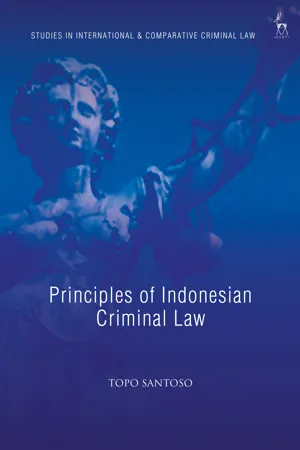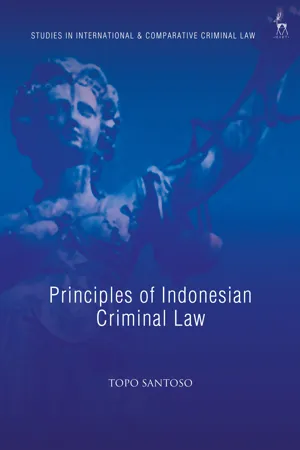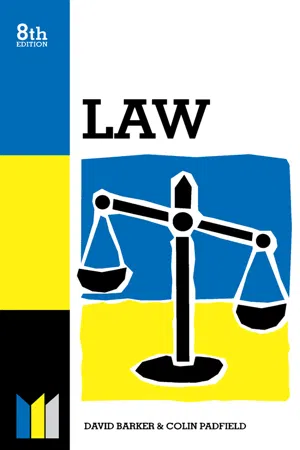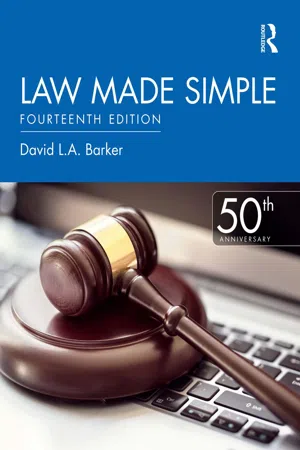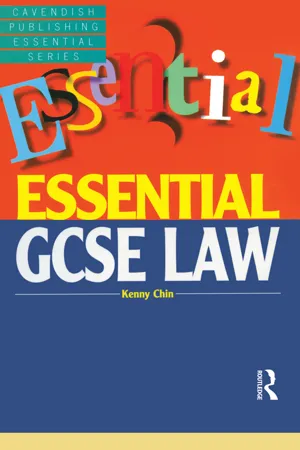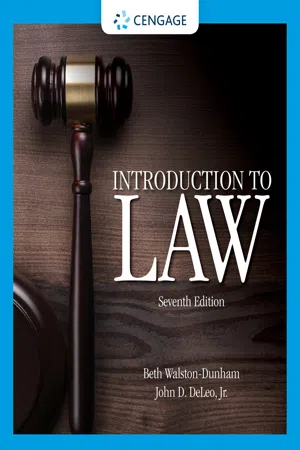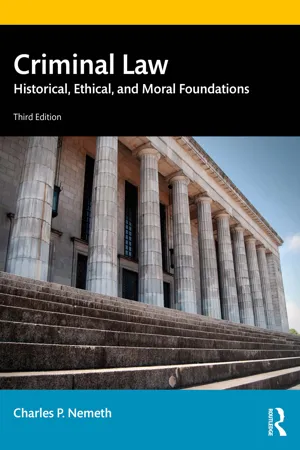Law
Criminal Offence
A criminal offence refers to an act that is prohibited by law and punishable by the state. It encompasses a wide range of behaviors, from minor infractions to serious felonies. The classification and punishment of criminal offences are typically outlined in a jurisdiction's legal statutes and can vary widely between different regions and legal systems.
Written by Perlego with AI-assistance
Related key terms
1 of 5
9 Key excerpts on "Criminal Offence"
- eBook - ePub
- Topo Santoso(Author)
- 2023(Publication Date)
- Hart Publishing(Publisher)
nalaten/omission), I also state that a Criminal Offence can also be committed by the failure to commit an act. Additionally, sometimes what is formulated in the law is not the action itself (formal offence), but the result of an action (substantive offence), therefore that result is also listed here. To distinguish this from violations in other legal fields, I emphasise that the act or series of actions is threatened with punishment and/or action according to laws and regulations.This definition is in line with the tendency of Indonesia’s new Criminal Code Bill to hold that every Criminal Offence is no longer reliant on fault (especially opzet/intention), but rather that every criminal act is considered to be have been conducted intentionally. In other words, only acts that are carried out intentionally are prohibited in the Criminal Code Bill, therefore there is no need to include this element in every Criminal Offence. Whether the person/corporation that commits the crime can be punished is a matter of criminal responsibility. Therefore, Criminal Offences are separated from criminal responsibility. The exception to this is certain punishable Criminal Offences which are committed as the result of negligence or omission, for which the element of negligence/omission must be clearly stated in the formulation of the crime.II.Types of Criminal OffenceIn the current Indonesian Criminal Code, Criminal Offences can be divided into two types: felony (regulated in Book 2 of the Criminal Code) and violation (Book 3). Special criminal laws outside the Criminal Code, as well as non-criminal laws containing criminal provisions, also sometimes contain Criminal Offences (both felonies and violations). Outside the Criminal Code, most laws specify which articles constitute a felony and which constitute a violation. However, there are also some laws that do not clearly define the distinction between felony and violation, raising problems in law enforcement because this distinction has implications for the implementation of criminal law. This is discussed particularly on the principle of an active nationality (Article 5 of the Criminal Code). To overcome this issue, in the new Criminal Code Bill, the distinction between felony and violation has been abolished; they have been combined and are referred to as ‘Criminal Offences’. Thus, although in the current Code there are three books, the new Criminal Code Bill contains only Book 1 on General Provisions and Book 2 on Criminal Offences. - eBook - PDF
- Topo Santoso(Author)
- 2023(Publication Date)
- Hart Publishing(Publisher)
This understanding includes a broader subject, covering not only humans but also corporations. A Criminal Offence is always against the law. I state ‘an act or a series of actions’ here considering that a crime can be carried out through one action or through a series of actions. To emphasise that an offence can consist of not only an act (active) but also negligence (nalaten/omission), I also state that a crim- inal offence can also be committed by the failure to commit an act. Additionally, sometimes what is formulated in the law is not the action itself (formal offence), but the result of an action (substantive offence), therefore that result is also listed here. To distinguish this from violations in other legal fields, I emphasise that the act or series of actions is threatened with punishment and/or action according to laws and regulations. This definition is in line with the tendency of Indonesia’s new Criminal Code Bill to hold that every Criminal Offence is no longer reliant on fault (especially opzet/intention), but rather that every criminal act is considered to be have been conducted intentionally. In other words, only acts that are carried out intentionally are prohibited in the Criminal Code Bill, therefore there is no need to include this element in every Criminal Offence. Whether the person/corporation that commits 94 Criminal Offences 29 For further details on the types or divisions of these offences, see Eddy OS Hiariej, Prinsip-Prinsip Hukum Pidana, Revised Edn (Yogyakarta, Cahaya Atma Pustaka, 2016) 134–50; Abidin and Hamzah, Pengantar Dalam Hukum Pidana Indonesia (2010) 126–35; Satochid Kartanegara, Hukum Pidana, Kumpulan Kuliah Prof Satochid Kartanegara (Jakarta, Balai Lektur Mahasiswa, nd) 91–130; Moeljatno, Asas-Asas Hukum Pidana (1993) 71–77; and PAF Lamintang and Fransiscus Theojunior Lamintang, Dasar-Dasar Hukum Pidana di Indonesia (Jakarta, Sinar Grafika, 2019) 207–25. the crime can be punished is a matter of criminal responsibility. - eBook - PDF
Law
Made Simple
- D. L. A. Barker, C. F. Padfield(Authors)
- 2014(Publication Date)
- Made Simple(Publisher)
12 CRIMINAL LAW 1. Definition of Crime Criminal law is concerned with conduct which the State considers should be punished, whereas civil law is concerned with private rights. A crime may be regarded as a public wrong; but conduct which is harmful to the public is not necessarily criminal. 'Crimes, then, are wrongs which the judges have held, or Parliament has from time to time laid down, are sufficiently injurious to the public to warrant the application of criminal procedure to deal with them.' (Smith and Hogan.) Nor is immoral conduct necessarily criminal; but conduct which would not be regarded as immoral may be criminal on grounds of social expediency. 'The domain of criminal jurisprudence can only be ascertained by examining what acts at any particular period are declared by the State to be crimes ...' (Lord Atkin.) This means that crime can only usefully be defined by reference to procedure: Ά crime (or offence) is a legal wrong that can be followed by criminal proceedings which may result in punishment.' (Glanville Williams). 2. Sources (a) Common Law. Many Criminal Offences were created by the common law courts and the definitions of some of these offences are to be found even today only in case law, e.g. murder, involuntary manslaughter, common assault. An offence remains a common law offence even when statute provides defences or penalties, e.g. Homicide Act, 1957. Today the courts have no power to create new offences; and this was acknowledged by the House of Lords in Knuller v. D.P.P. (1973). In an earlier case before the House of Lords, Shaw v. D.P.P. (1962), Lord Simonds L.C. seemed to be claiming otherwise when he stated that 'there remains in the courts of law a residual power to enforce the supreme and fundamental purpose of the law to conserve not only the safety and order but also the moral welfare of the state'. (b) Textbooks. These are not sources, but certain early works—e.g. - eBook - ePub
- David L.A. Barker, David L. A. Barker(Authors)
- 2020(Publication Date)
- Routledge(Publisher)
Chapter 12Criminal law
Key points
- structure and classification of a criminal law
- the elements of criminal liability
- offences against the person
- offences against property
12.1 Definition of crime
Criminal law is concerned with conduct that the State considers should be punished, whereas civil law is concerned with private rights. A crime may be regarded as a public wrong; but conduct that is harmful to the public is not necessarily criminal. ‘Crimes, then, are wrongs which the judges have held, or Parliament has from time to time laid down, are sufficiently injurious to the public to warrant the application of criminal procedure to deal with them’ (Smith and Hogan). Nor is immoral conduct necessarily criminal; but conduct that would not be regarded as immoral may be criminal on grounds of social expediency. ‘The domain of criminal jurisprudence can only be ascertained by examining what acts at any particular period are declared by the State to be crimes…’ (Lord Atkin).This means that crime can only usefully be defined by reference to procedure: ‘A crime (or offence) is a legal wrong that can be followed by criminal proceedings which may result in punishment’ (Glanville Williams).12.2 Sources
(a) Common law
Many Criminal Offences were originally created by the common-law courts and the definitions of some of these offences are to be found even today only in case law, e.g. murder, involuntary manslaughter, common assault.An offence remains a common-law offence even when statute provides defences or penalties, e.g. Homicide Act 1957 .Today the courts have no power to create new offences; and this was acknowledged by the House of Lords in Knuller v DPP (1973). In an earlier case before the House of Lords, Shaw v DPP - eBook - ePub
- Kenny Chin(Author)
- 2014(Publication Date)
- Routledge-Cavendish(Publisher)
3 Criminal LawNature of criminal liability What is crime?You should be familiar with the following areas:• various elements in crime• mens rea, actus reus and strict liability• minors in criminal law• definition and specific defences of murder• different forms of manslaughter• definitions and requirements of various assault offences• definitions and requirements of theft and other offences against property• various general defences and their applicationsHalsbury’s Laws of England defines crime as:… an unlawful act or default which is an offence against the public and renders the person guilty of the act or default liable to legal punishment.Two main objectives of criminal law are: (a) to punish and reform the offenders; and (b) to protect the public and individuals from harm which may be caused by the unlawful act or default. Classification of crime The following are three main ways that various offences can be classified: Classification by the method of trialThere are summary, indictable and either way offences. Summary offences are those which are triable in magistrates’ courts only and heard by magistrates. They are usually less serious crimes. Indictable offences are those which can only be tried in the Crown Court, heard by a judge and a jury. The judge deals with issues of law and the jury decides on facts. There are also either-way offences, which can be tried either in magistrates’ courts or the Crown Court. All criminal cases start in magistrates’ courts; therefore, if a case is an either way offence or an indictable offence, there are procedures to decide in which court the matter is to be heard and to transfer the case to the Crown Court. Further details of these procedures are stated in Chapter 9 .Statutory and common law offencesStatutory offences are those crimes that are provided by Acts of Parliament or by delegated legislation. The Act or the regulation normally provides a statutory definition for the offence. All the elements stated in the definition have to be proven before an accused can be convicted. Examples include various offences against property such as theft, robbery, burglary and many others that are provided in the Theft Act 1968 and the Theft Act 1978. Common law offences are those which were created by the common law system, for example, murder. Some crimes can be statutory as well as common law offences, for example, assault and battery. The Offences Against the Person Act 1861 has defined several assault related offences providing different maximum penalties according to the seriousness of the offence. The Act, however, has not abolished the common law assault and battery, which therefore have survived the statute. - eBook - PDF
- Beth Walston-Dunham(Author)
- 2019(Publication Date)
- Cengage Learning EMEA(Publisher)
Categories of Crime The two basic categories of crimes are felony and misdemeanor. A felony is any offense punishable by death or by imprisonment exceeding one year. A misdemeanor is a crime punishable by fine or by detention of one year or less in a jail or an institution other than a penitentiary. 2 Many states have further divided felonies and misdemeanors into subclasses, usually for the purpose of sentencing. For example, crimes that are consid -ered Class 1 misdemeanors may carry a heavier penalty than crimes considered Class 2 misdemeanors. Once the classes are established, the various crimes are placed within a class. The definition of the criminal offense itself will indicate the elements necessary for someone to be convicted of the crime. The category and subclass will indicate to the court what sentence should be imposed on someone who is found guilty of that crime. In some cases, a mandatory sentence is required. This means that the judge has no discretion to impose or suspend a sentence. The statute prescribes exactly what the sentence must be. In the absence of a mandatory sentence, the judge usually works within a recommended range of punishments. The judge is responsible for imposing a sentence within this range that will adequately punish the defendant for the crime com -mitted. This range allows the judge to take the circumstances of each case into account. Definition of Crime and the Elements of Criminal Conduct Crime has been defined as conduct in violation of the criminal laws of a state, the fed -eral government, or a local jurisdiction, for which there is no legally acceptable justifi -cation or excuse. 3 In more general terms, criminal conduct refers to acts that may be injurious not only to an individual but also, and more importantly, to society. All persons in society should have the right to expect and enjoy certain basic privileges, including privacy, ownership of property, and physical safety. - eBook - PDF
- Richard Mann, Barry Roberts(Authors)
- 2019(Publication Date)
- Cengage Learning EMEA(Publisher)
Crimes are prohibited and punished on grounds of public policy, which may include the protection and safeguarding of government (as in treason), human life (as in murder), or private property (as in larceny). Additional purposes for criminal law include deterrence, rehabilitation, and retribution. Historically, criminal law was primarily common law. In the twenty-first century, however, criminal law is almost exclusively statutory. All states have enacted comprehensive criminal law statutes (or codes) cover- ing most, if not all, of the common law crimes. Since its promulgation in 1962, the American Law Institute’s Model Penal Code has played an important part in the widespread revision and codification of the substantive criminal law of the United States. Moreover, these stat- utes have made the number of crimes defined in criminal law far greater than the number of crimes defined under common law. Some codes expressly limit crimes to those the code includes, thus abolishing common law crimes. Nonetheless, some states do not define all crimes statuto- rily; therefore, the courts must rely on common law defi- nitions. Because there are no federal common law crimes, all federal crimes are statutory. Within recent times, the scope of the criminal law has increased greatly. The scope of traditional criminal behav- ior has been expanded by numerous regulations and laws, pertaining to nearly every phase of modern living, that contain criminal penalties. Typical examples in the field of business law are those laws concerning the licensing and conduct of a business, antitrust laws, and laws governing the sales of securities. Essential Elements [6-1a] In general, a crime consists of two elements: (1) the wrongful or overt act (actus reus) and (2) the criminal or mental intent (mens rea). For example, to support a lar- ceny conviction, it is not enough to show that the defen- dant stole another’s goods; it also must be established that he intended to steal the goods. - eBook - PDF
- Charles P. Nemeth(Author)
- 2011(Publication Date)
- Routledge(Publisher)
5 Definitions of Crime 36 Crime as a Moral and Religious Judgment Every government or political–social structure has declared some types of conduct as unaccept-able. From the time of ancient society, a system of criminal law and aligned corrective powers has existed. The Latin word, crimen , meaning “sin,” says much about our criminal heritage. While the political and social system declares behavior illegal for practical and communal reasons, crim-inal behavior has also been characterized as sinful, wrong, an affront to God or the gods and an act inconsistent with theological order. In this sense, crime defines itself by political, social, and cultural realities, but also by judgments that involve correctness and good. Crime, in each situation, represents the judgment of others, the finding that certain types of conduct are wrong and reprehensible, and penalties are properly inflicted on those who engage in this activity. In criminal law, we discern a “soft or hard coercion and a series of guiding influences to keep the citizen morally erect. Punishment is ‘especially necessary against those who are prone to evil.’ 6 Rewards as well as punishments … are devised ‘so that men may be drawn away from evil things and toward good things.’ 7 Laws not backed by correction would be hollow admonitions.” 8 The business of criminal law is tied tightly to moral judgment—a conclusion that some behav-iors are fundamentally suspect. Hence, murder, incest, theft, and maiming others garner legiti-macy from few quarters. These offenses are prohibited because their content is essentially or inherently evil. This type of conduct, amongst others, is labeled and defined mala in se —corrupt in and of themselves and devoid of any rational defense. For the classical and medieval mind, crime was more the sin than the infraction. Crime was an affront to nature, to communal goods, and the moral ordering inherent in the human person. - eBook - ePub
Criminal Law
Historical, Ethical, and Moral Foundations
- Charles P. Nemeth(Author)
- 2022(Publication Date)
- Routledge(Publisher)
Treatise on Crimes delivers a very workable definition as compared to civil harm:A crime is any act or omission prohibited by public law for the protection of the public, and made punishable by the state in a judicial proceeding in its own name. It is a public wrong, as distinguished from a mere private wrong or civil injury to an individual.4The crime also can be analyzed holistically and then by the sum of its parts. The body of the crime, the corpus delicti, its elemental qualities, so to speak, the content of the offense, comprises the act known as crime. So, a murder is an act that consists of various elements that constitute the body of a crime, namely the actor acting, the victim killed, and the actor’s wish and desire to simultaneously affect this end. Dean Wigmore’s classic treatise on evidence sums up this definition precisely:It is clear that an analysis of every crime, with reference to this element of it, reveals three component parts, first, the occurrence of the specific kind of injury or loss (as, in homicide, a person deceased***);… secondly, somebody’s criminality (in contrast, e.g., to accident) as the source of the loss, these two together involving the commission of a crime by somebody; and, thirdly, the accused’s identity as the doer of this crime.5Within the pages that follow, the reader will analytically dissect the body, the components, and elements that make up specific offenses. By learning the parts, one gains the fullest understanding of what crimes are, and what content of proof is necessary to convict or defend. From the conception of the whole, we arrive at particular determinations of crimes. In each crime exists these rudimentary elements:
Index pages curate the most relevant extracts from our library of academic textbooks. They’ve been created using an in-house natural language model (NLM), each adding context and meaning to key research topics.
